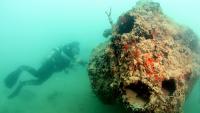 Minutes before the beginning of the attack on the warships of Pearl Harbor on December 7, 1941, Japanese Imperial Navy planes bombed the nearby U.S. Naval Air Station on the east coast of Oahu, destroying twenty-seven Catalina PBY seaplanes on the ground or moored on Kāne‛ohe Bay. Six others were damaged. The PBYs were a strategic target for the Japanese because the long-range patrol bombers could have potentially followed the Japanese planes back to their carriers. Last Thursday, NOAA and University of Hawaii archeologists released rare images of the wreck of a U.S. Navy Catalina PBY-5 seaplane where it rests in three large pieces at a depth of 30 feet in the murky waters of Kāne‛ohe Bay.
Minutes before the beginning of the attack on the warships of Pearl Harbor on December 7, 1941, Japanese Imperial Navy planes bombed the nearby U.S. Naval Air Station on the east coast of Oahu, destroying twenty-seven Catalina PBY seaplanes on the ground or moored on Kāne‛ohe Bay. Six others were damaged. The PBYs were a strategic target for the Japanese because the long-range patrol bombers could have potentially followed the Japanese planes back to their carriers. Last Thursday, NOAA and University of Hawaii archeologists released rare images of the wreck of a U.S. Navy Catalina PBY-5 seaplane where it rests in three large pieces at a depth of 30 feet in the murky waters of Kāne‛ohe Bay.
There have been three attempts to photograph the wreck of the seaplane. In 1994 and 2008, attempts to photograph the wreck failed due to the murky water. Last June, with clearer water conditions and better camera equipment, a team of students from the University of Hawaii Marine Option Program conducted a detailed archeological survey of the wreck and produced the first systematic photo and video documentation of the entire site. The effort was coordinated by Hans Van Tilburg, a maritime archeologist with NOAA’s Office of National Marine Sanctuaries.
“The new images and site plan help tell the story of a largely forgotten casualty of the attack,” Van Tilburg said. “The sunken PBY plane is a very important reminder of the “Day of Infamy,’ just like the USS Arizona and USS Utah. They are all direct casualties of December 7.”
New photos show US Navy seaplane lost in Pearl Harbor attack
Thanks to Phil Leon for contributing to this post.
